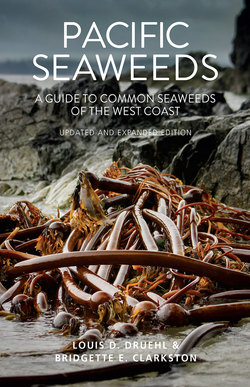Читать книгу Pacific Seaweeds - Louis Druehl - Страница 30
На сайте Литреса книга снята с продажи.
ОглавлениеPacific Seaweeds
30
section (p. 281) points out the advantages and joys of eating seaweed, but this is not an endorsement of wild foraging. Sea vegetables are commercially available, having been produced on farms or harvested from the wild under controlled, sustainable conditions.
If you must make collections, do so sparingly and never remove a rare seaweed—take a photograph. A correct scientific collection requires that the entire organism be removed, as the nature of the attachment organ along with the more conspicuous plant parts are important in making detailed identifications. If you collect into plastic bags, remember that they turn into miniature greenhouses if exposed to the sun, quickly cooking your algae. Keep specimens of the brown seaweed Desmarestia (p. 193, 198) separate from other seaweeds. Desmarestia releases sulfuric acid when in captivity, which will destroy your other collections.
The best way to preserve seaweeds attractively is to press them to dryness. Arrange fresh plants on quality paper, such as herbarium paper. Fine-structured plants may be floated on the paper from a shallow tray containing seawater and then teased into a striking arrangement with a watercolour brush and needle. Then cover the plants with a clean cotton cloth and press them in a plant press. A plant press is an elaborate sandwich: outer layers of corrugated cardboard (which allow for the passage of air through the sandwich), inner layers of absorptive paper such as newspaper (to draw moisture away from the plant to the cardboard) and in the middle the herbarium paper, with its arranged plant, covered with a clean cloth. This process may be repeated over and over, creating a stack of pressed plants. The stack is sandwiched in with plywood and compressed with weights or cinched straps. When the plants are dry (they no longer feel cool to the touch), the cloth is carefully peeled off to reveal an attractive plant adhering to the paper by its own glue—a glue that prefers paper to cloth. For thick plants, it may be necessary to replace the newspaper to dry the plant fully. This process will produce eye-catching preserved specimens of many seaweeds, a notable exception being the coralline algae (red seaweeds with a hard calcareous covering, p. 76). The artist Josie Iselin has a stunning photobook of pressed seaweeds that cannot fail to inspire you.
